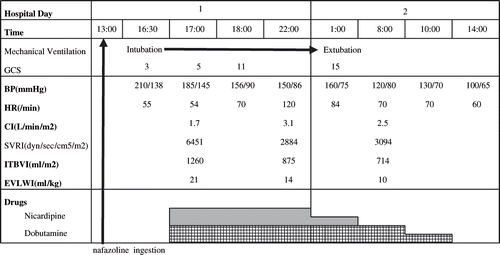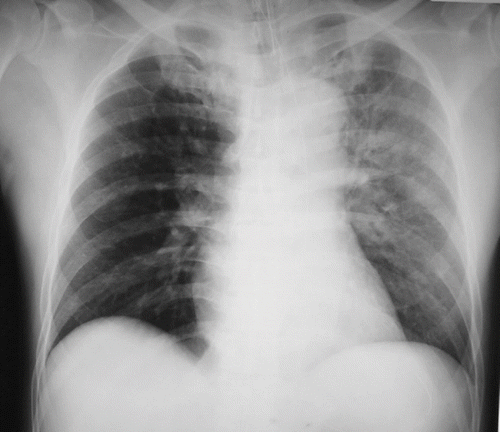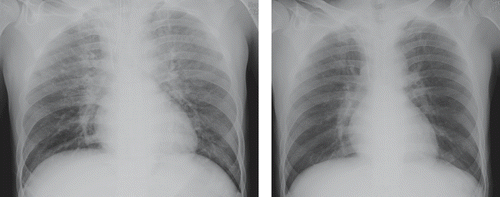Abstract
In published reports of naphazoline ingestion, clinical effects are hypertension, bradycardia, pallor, diaphoresis, and respiratory distress. We report three cases of acute pulmonary edema after the intentional ingestion of naphazoline-containing antiseptic first aid liquid. These cases presented with altered mental status, hypertension, bradycardia, and diaphoresis. Chest x-ray on admission revealed acute pulmonary edema. Two cases required mechanical ventilation. All of these clinical effects resolved within 24 hours and the patients were discharged with no sequelae. Since naphazoline stimulates the peripheral alpha-2 adrenergic receptor, we speculate that intense vasoconstriction may have elevated cardiac afterload and left atrial-ventricular blood volume and caused acute pulmonary edema.
Introduction
Naphazoline, an imidazoline derivative, is a sympathomimetic drug that is mostly employed as a topical nasal or ocular decongestant. In Japan, antiseptic first aid liquids containing naphazoline are sold in drug stores and are available without a doctor's prescription. Naphazoline stimulates central and peripheral alpha-2 adrenergic receptors causing central nervous depression and peripheral vascular constriction. The common clinical effects of naphazoline overdose are hypertension, bradycardia, pallor, diaphoresis, and respiratory distress (Citation1–3). Acute pulmonary edema after naphazoline ingestion has not been reported. We present three adult cases of acute pulmonary edema following ingestion of a naphazoline-containing antiseptic first aid liquid in suicide attempts (Citation4).
Case 1
A 53-year-old man ingested an antiseptic first aid liquid (0.1% naphazoline) in an attempt to commit suicide about four hours prior to admission. On admission, he was comatose and his blood pressure was 160/100 mmHg, heart rate was 72 beats/min, and respiratory rate was 10 breaths/min. Findings from physical examination of the chest and abdomen were normal. Results of arterial blood gas analysis (on face mask oxygen at 5 L/min) were pH 7.382, PaO2 60.4 mmHg, and PaCO2 42.0 mmHg. A chest x-ray revealed pulmonary edema in the left lung field (). He was intubated because of cessation of spontaneous breathing and was admitted to the intensive care unit. Sixteen hours after admission, he became alert and his cardiopulmonary status recovered spontaneously. He was discharged with arrangements made for a consultation with a psychiatrist.
Case 2
A 40-year-old man with a history of depression ingested an antiseptic first aid liquid (0.1% naphazoline) in a suicide attempt. About an hour after ingestion, he vomited and complained of nausea and headache. On admission, two hours post-ingestion, he was diaphoretic and his Glasgow Coma Scale was 10 (E3 V3 M4). His blood pressure was 182/100 mmHg and heart rate was 38 beats/min. On lung ausculation, wet rales were heard bilaterally. A chest x-ray revealed bilateral pulmonary edema with mild cardiac enlargement. Results of arterial blood gas analysis (on face mask oxygen at 5 L/min) were pH 7.347, PaO2 71.5 mmHg, and PaCO2 41.1 mmHg. Doxapram hydrochloride was administered at a dose of 150 mg intravenously because his respiratory rate had decreased to 8 breaths/min. Before admission to the intensive care unit, his cardiopulmonary status recovered and chest x-ray cleared. He was discharged on the following day without sequelae.
Case 3
A previously healthy 32-year-old man with a 2-year history of depression ingested three bottles of antiseptic first aid liquid (total amount of naphazoline, 225mg) in a suicide attempt. Two hours later, his family found him unconscious and he was brought to our emergency center. On admission, he was diaphoretic and his Glasgow Coma Scale was 3. His blood pressure was 210/138 mmHg, heart rate 52 beats/min, and respiratory rate 8 breaths/min. A chest x-ray revealed mild pulmonary edema and mild cardiac enlargement (, left). He was intubated and put on a ventilator. Nicardipine was started at a dose of 3 mg/h for the severe hypertension. The results of arterial blood gas analysis (FiO2 0.6) were pH 7.353, PaO2 299.9 mmHg, PaCO2 42.2 mmHg, base excess −2.2 mmol/L, HCO3- 22.8 mmol/L, and serum lactate 32 mg/dl. Complete blood cell count and results of blood biochemistry tests were unremarkable. He was admitted to the intensive care unit. PiCCO monitoring system (Pulsion Medical systems AG, Munich, Germany) revealed a low cardiac index ( = 1.7 L/min/m2), increased intrathoracic blood volume index (ITBVI = 1260 ml/m2, normal 850–1000 ml/m2), and elevated extravascular lung water index (EVLWI = 21 ml/kg, normal <7 ml/kg). Fluid infusion was decreased (500 ml/h to 100 ml/h) and dobutamine (6 mcg/kg/min) was started to increase cardiac output. About 12 hours after ingestion, spontaneous breathing was restored and the patient became alert. Blood pressure returned to a normal range. His cardiac index was increased to 2.5 L/min/m2, ITBVI decreased to 714 ml/m2 and EVLWI decreased to 10 ml/kg. A chest x-ray showed resolution of the pulmonary edema (, right). He was discharged from the intensive care unit and transferred to a psychiatric ward ().
Fig. 3. Clinical course of Case 3. The patient ingested 225 mg of nafazoline at 13:00 on hospital day 1. On arrival, he was comatose and blood pressure (BP) was 210/138 mmHg; Cardiac Index (CI) was lower. About 12 hours after arrival he became alert. HR: heart rate; SVRI: systemic vascular resistance index; ITBVI: intrathoracic blood volume index; EVLWI: extravascular lung water index.

Discussion
These three cases developed acute pulmonary edema soon after ingestion of a naphazoline-containing antiseptic first aid liquid. This antiseptic, which is available at any drug store in Japan, also contains 0.1% dibucaine hydrochloride and 0.2% chlorpheniramine maleate. Acute pulmonary edema caused by these two drugs has not been reported (Citation5,Citation6). Because of their pharmacologic properties, dibucaine hydrochloride and chlorpheniramine maleate are unlikely to have been the causative agent. We did not measure naphazoline in the blood or urine of any of our patients. However, since imidazoline intoxication induces hypertension by peripheral vascular constriction (Citation2), naphazoline was probably the cause of the acute pulmonary edema. Intense hypertension and pulmonary edema after sympathomimetic drug administration have been reported (Citation7–9). Catecholamines or other vasoconstrictiveagents increase peripheral vascular tone, which is followed by severe hypertension, increased cardiac afterload, decreased cardiac output, increased cardiac blood volume, and elevated left atrial pressure. These hemodynamic changes may produce acute pulmonary edema. We speculate that the naphazoline overdose caused acute pulmonary edema through the same mechanism as a sympathomimetic drug overdose. Stamer et al. reported a pediatric case of acute pulmonary edema induced by naphazoline and speculated that the same mechanism was responsible (Citation10). In case 3, PiCCO monitoring showed an unusually elevated systolic and diastolic blood pressure with decreased cardiac output, increased ITBVI and EVLWI. These data suggest that naphazoline excessively elevated the cardiac afterload, which increased cardiac blood volume, followed by development of acute pulmonary edema.
In the literature on naphazoline ingestion, most reports are of unintentional naphazoline exposure in children from nasal or ocular decongestants. In most of these naphazoline-containing over-the-counter drugs, the concentration of naphazoline is between 0.05% and 0.1% (Citation1,Citation3). The antiseptic first aid liquid that the presented cases ingested also contains 0.1% naphazoline. Our cases were suicidal adults, so the patients ingested much more naphazoline than the published pediatric cases and exhibited a more severe clinical course. In Stamer's report, intrabronchial application of 3–4 mg naphazoline-induced pulmonary edema (Citation10). Since imidazoline derivatives have a narrow therapeutic window, especially in children, any drug that contains naphazoline might cause acute pulmonary edema. Naphazoline-induced symptoms resolve within 24 hours and close observation of the clinical course is important. For severe cases, such as those that we described, intensive management such as mechanical ventilation and cardiovascular monitoring may be required.
In summary, we reported acute pulmonary edema temporally related to intentional naphazoline ingestion. Intense vasoconstriction by alpha-2 adrenergic receptor stimulation results in acute pulmonary edema. Physicians should be aware of the toxicity of naphazoline on the cardiopulmonary system.
References
- Bucaretchi F, Dragosavac S, Vieira RJ. Acute exposure to imidazoline derivatives in children. J Pediatr 2003; 79: 519–24
- Mahieu LM, Rooman RP, Goossens E. Imidazoline intoxication in children. Eur J Pediatr 1993; 152: 944–46
- Higgins GL, Campbell B, Wallace K, Talbot S. Pediatric poisoning from over-the-counter imidazoline-containing products. Ann Emerg Med 1991; 20: 655–58
- Konobu T, Ueyama T, Fukushima H, Seki T, Nishigucui T, Norimoto K, Urizono Y, Hata M, Nakamura T, Okuchi K. Acute pulmonary edema by antiseptic first aid liquid containing naphazoline: A case report. Jpn J Chest Dis 2006; 65: 294–99
- McClenahan UW. Fatal poisoning with dibucaine hydrochloride (NUPORAL) lozenges. J Am Med Assoc 1955; 158: 565
- Wogoman H, Steinberg M, Jenkins AJ. Acute intoxication with guaifenesin, diphenhydramine, and chlorpheniramine. Am J Forensic Med Pathol 1999; 20: 199–202
- Mazzocca AD, Meneghini RM, Chhablani R, Badrinath SK, Cole BJ, Bush CA. Epinephrine-induced pulmonary edema during arthroscopic knee surgery. J Bone Joint Surg 2003; 85: 913–15
- Kademani D, Voiner JL, Quinn PD. Acute hypertensive crisis resulting in pulmonary edema and myocardial ischemia during orthognathic surgery. J Oral Maxillofac Surg 2004; 62: 240–43
- Fahmy N, Assaad M, Bathija P, Whittier FC. Postoperative acute pulmonary edema: A rare presentation of pheochromocytoma. Clinical Nephrology 1997; 48: 122–4
- Stamer UM, Buderus S, Wetegrove S, Lentze MJ, Stuber F. Prolonged awakening and pulmonary edema after general anesthesia and naphazoline application in an infant. Anesth analg 2001; 93: 1162–1164

